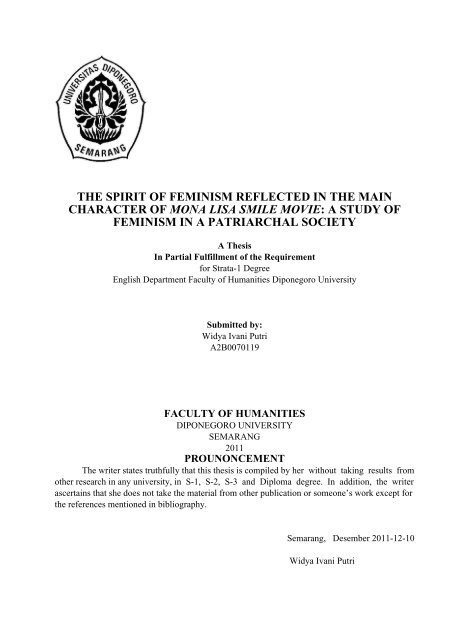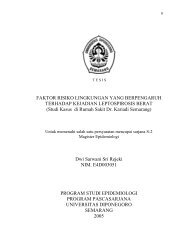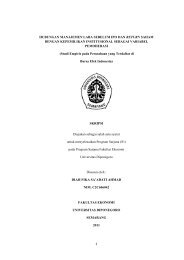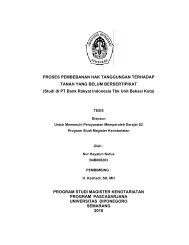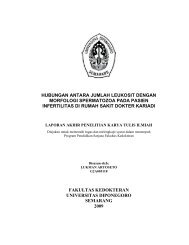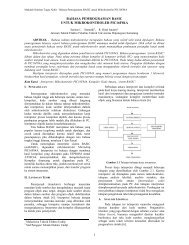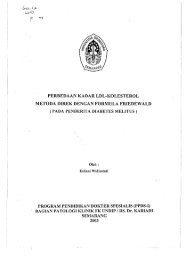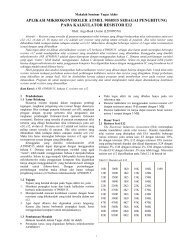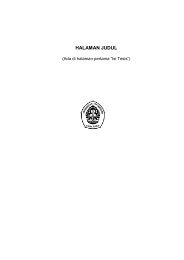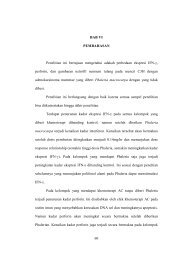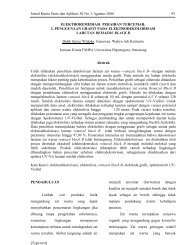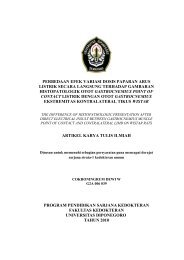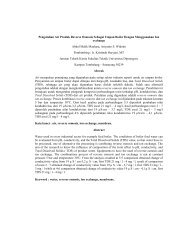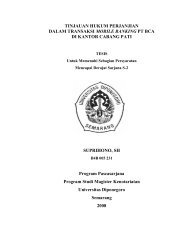THE SPIRIT OF FEMINISM REFLECTED IN THE MAIN ... - Undip
THE SPIRIT OF FEMINISM REFLECTED IN THE MAIN ... - Undip
THE SPIRIT OF FEMINISM REFLECTED IN THE MAIN ... - Undip
You also want an ePaper? Increase the reach of your titles
YUMPU automatically turns print PDFs into web optimized ePapers that Google loves.
<strong>THE</strong> <strong>SPIRIT</strong> <strong>OF</strong> <strong>FEM<strong>IN</strong>ISM</strong> <strong>REFLECTED</strong> <strong>IN</strong> <strong>THE</strong> MA<strong>IN</strong><br />
CHARACTER <strong>OF</strong> MONA LISA SMILE MOVIE: A STUDY <strong>OF</strong><br />
<strong>FEM<strong>IN</strong>ISM</strong> <strong>IN</strong> A PATRIARCHAL SOCIETY<br />
A Thesis<br />
In Partial Fulfillment of the Requirement<br />
for Strata-1 Degree<br />
English Department Faculty of Humanities Diponegoro University<br />
Submitted by:<br />
Widya Ivani Putri<br />
A2B0070119<br />
FACULTY <strong>OF</strong> HUMANITIES<br />
DIPONEGORO UNIVERSITY<br />
SEMARANG<br />
2011<br />
PROUNONCEMENT<br />
The writer states truthfully that this thesis is compiled by her without taking results from<br />
other research in any university, in S-1, S-2, S-3 and Diploma degree. In addition, the writer<br />
ascertains that she does not take the material from other publication or someone’s work except for<br />
the references mentioned in bibliography.<br />
Semarang, Desember 2011-12-10<br />
Widya Ivani Putri
APPROVAL<br />
Approved by:<br />
Thesis Advisor,<br />
Dra. Dewi Murni, M.A<br />
NIP. 194508081975011001
VALIDATION<br />
Approved by<br />
Strata -1 Thesis Examination Committee<br />
English Department<br />
Faculty of Humanities, Diponegoro University<br />
On Desember 2011<br />
Chair Person,<br />
Sukarni Suryaningsih, S.S, M.Hum<br />
NIP. 197212231998022001<br />
First Member Second Member<br />
Dra. Dewi Murni, M.A Arido Laksono, S.S, M.Hum<br />
NIP. 194508081975011001 NIP. 197507111999031002
MOTTO<br />
“NEVER TROUBLE ABOUT TROUBLE BEFORE TROUBLE TROUBLES<br />
YOU”<br />
(The writer)<br />
HAL TER<strong>IN</strong>DAH DALAM HIDUP ADALAH KETIKA BISA MELIHAT<br />
ORANGTUA TERSENYUM DAN KITA ADALAH ALASAN DIBALIKNYA<br />
(The writer)
DEDICATION<br />
This paper is dedicated to :<br />
My beloved family<br />
My dearest “yangsa”, friends and everyone<br />
who help me accomplish this paper
ACKNOWLEDGEMENT<br />
Praise be to Allah, the Cherisher and Sustainer of the worlds, for the mercy and guidance<br />
so that the writer can finish this thesis. Much peace and blessing also are upon the Prophet,<br />
Muhammad, SAW.<br />
On this occasion, the writer would like to thank all of the people who have contributed to<br />
completion of the thesis. This deepest gratitude and appreciation is given to Drs. Sunarwoto, M. S,<br />
M. A. as the writer’s advisor, for his guidance, helpful corrections, cooperation, time, patience and<br />
kindness until this thesis is completed.<br />
The writer would also like to extend special thanks to:<br />
1. Dr. Agus Maladi Irianto, M.A., as the Dean of Faculty of Humanities Diponegoro<br />
University.<br />
2. Dra. Ratna Asmarani, M. Ed, M. Hum., as the Head of English Department Faculty of<br />
Humanities Diponegoro University.<br />
3. Sukarni Suryaningsih, S. S., M. Hum., as the head of American Studies Section who<br />
always gives good advice in classses.<br />
4. Dra. Dewi Murni, M. A, as the writer’s academic advisor for his guidance from the first<br />
semester until now.<br />
5. All of the lecturers in the Englsih Department for sharing their knowledge.<br />
6. Her beloved father Wiyono, mother Sri Suprapti and sister Riska Fita who always support<br />
and motivate the writer.<br />
7. Her beloved “Yangsa” who support, help, and motivate the writer all this time.<br />
8. All friends in Faculty of Humanities especially in “D”, ”E” class, Oktavia, Mbak Sar, Sapu<br />
and all friends in American Studies section.<br />
The writer realizes that this thesis is far from perfect. She, therefore will be glad to receive<br />
any constructive criticism and recommendation to make this thesis better. Finally, the<br />
writer expects this thesis will be usefull for all the readers.<br />
The writer,
Widya Ivani Putri
TABLE <strong>OF</strong> CONTENT<br />
TITLE.............................................................................................................................. i<br />
PRONOUNCEMENT.................................................................................................... ii<br />
APPROVAL................................................................................................................... iii<br />
VALIDATION..............................................................................................................<br />
iv<br />
MOTTO........................................................................................................................... v<br />
DEDICATION............................................................................................................... vi<br />
ACKNOWLEDGEMENT.............................................................................................. vii<br />
TABLE <strong>OF</strong> CONTENT.................................................................................................. ix<br />
ABSTRACT.................................................................................................................... xii<br />
CHAPTER 1 <strong>IN</strong>TRODUCTION ................................................................................... 1<br />
1. Background of the Study.................................................................................. 1<br />
2. Scope of the Study..................................................................................... ...... 2<br />
3. Objectives of the Study.................................................................................... 2<br />
4. Research and Approach Method...................................................................... 3<br />
5. Organization of Writing.................................................................................... 3<br />
CHAPTER 2 SUMMARY............................................................................................... 5<br />
CHAPTER 3 LITERARY REVIEW.............................................................................. 7<br />
3.1. Film ............................................................................................................... 7<br />
3.2. Intrinsic Aspects ............................................................................................ 8<br />
3.2.1. Setting ................................................................................................. 8<br />
3.2.2. Character ............................................................................................. 9<br />
3.2.3. Plot ...................................................................................................... 9<br />
3.2.3.1. Exposition .................................................................................... 9<br />
3.2.3.2. Complication ............................................................................... 9<br />
3.2.3.3. Climax ......................................................................................... 9<br />
3.2.3.4. Anti-climax .................................................................................. 9<br />
3.2.3.5. Resolution .................................................................................... 9<br />
3. Cinematoghraphy Aspects ............................................................................. 11<br />
1. Establishing Shot ................................................................................. 11<br />
1. Extreme Long Shot ...................................................................... 11
2. Long Shot ..................................................................................... 12<br />
3. Medium Long Shot ....................................................................... 12<br />
4. Medium Shot ................................................................................ 12<br />
5. Medium Close Up ........................................................................ 13<br />
6. Close Up ...................................................................................... 13<br />
7. Extreme Close Up ........................................................................ 13<br />
2. Angle .................................................................................................. 14<br />
1. High Angle .................................................................................. 14<br />
2. Straight-on Angle ........................................................................ 14<br />
3. Low Angle ................................................................................... 15<br />
3. Sound .................................................................................................. 15<br />
1. Dialogue ...................................................................................... 15<br />
2. Music ........................................................................................... 15<br />
3. Sound Effect ............................................................................... 16<br />
4. Mise-en-scene ..................................................................................... 16<br />
1. Setting .......................................................................................... 16<br />
2. Costume ....................................................................................... 16<br />
3. Acting .......................................................................................... 16<br />
4. Extrinsic Aspect ............................................................................................ 17<br />
1. Patriarchy ............................................................................................ 17<br />
2. Feminism ............................................................................................ 19<br />
CHAPTER 4 DISCUSSION ......................................................................................... 21<br />
4.1. Setting .......................................................................................................... 21<br />
4.2. Character ...................................................................................................... 22<br />
4.2.1. Major Character ................................................................................. 22<br />
4.2.2. Minor Characters ............................................................................... 23<br />
4.2.2.1. Elizabeth Warren ....................................................................... 24<br />
4.2.2.2. Joa Brandwyn ............................................................................ 24
4.3. Plot ............................................................................................................... 25<br />
4.3.1. Exposition .......................................................................................... 25<br />
4.3.2. Complication ..................................................................................... 28<br />
4.3.2.1. Traditionalist vs Katherine Watson’s Ideology..................... 28<br />
4.3.2.2. Patriarchy vs Katherine Watson’s Spirit of Feminism........... 33<br />
4.3.3. Climax ............................................................................................... 41<br />
4.3.4. Resolution .......................................................................................... 41<br />
CHAPTER 5 CONCLUSION ...................................................................................... 43<br />
REFERENCES .............................................................................................................. 44
ABSTRAK<br />
Film merupakan karya sastra audio-visual yang akhir-akhir ini menyita banyak minat<br />
masyarakat. Hal ini dikarenakan film bukan hanya berfungsi sebagai sarana hiburan namun juga<br />
merupakan refleksi dan inspirasi kehidupan masyarakat yang sarat akan nilai-nilai sosial dan<br />
moral sehingga dapat dikaji lebih dalam.<br />
Mona Lisa Smile merupakan salah satu film yang menyajikan cerita mengenai ideologi<br />
feminisme dimana pandangan tersebut sangat bertentangan dengan aturan-aturan sebuah<br />
lingkungan masyarakat akademis yang cenderung patriarki. Dalam hal ini penulis ingin mengkaji<br />
lebih dalam mengenai pandangan feminis Katherine Watson, tokoh utama dalam film tersebut dan<br />
usahanya mengubah pandangan patriarki masyarakat Wellesley yang terlalu memposisikan pria<br />
sebagai “yang berkehendak” dan memandang wanita sebagai umat yang sudah ditakdirkan untuk<br />
mengisi sebuah peran sebagai istri dan ibu dalam hidup mereka.<br />
Adapun metode penelitian yang digunakan untuk menganalisis film tersebut adalah<br />
metode penelitian pustaka dimana penulis menggunakan buku-buku referensi serta sumber dari<br />
koran, majalah, artikel maupun internet untuk mendukung kajian analisisnya. Metode<br />
eksponensial juga digunakan yakni untuk menganalisis aspek-aspek naratif seperti latar, karakter<br />
dan plot; aspek sinematik seperti penggunaan kamera dan mise-en-scenes; serta aspek ekstrinsik<br />
yang penulis fokuskan pada analisis patriarki dan feminisme. Akhirnya, kesimpulan akhir dari<br />
analisis fim Mona Lisa Smile ini adalah bahwa meski banyak cercaan dan kritik yang dialami<br />
Katherine Watson di Wellesley, namun hal itu tidak membuatnya berhenti. Pemikiran feminisnya<br />
yang pada dasarnya menuntut masa depan yang lebih baik dari mahasiswa lulusan Wellesley dari<br />
pada sekedar menjadi ibu rumah tangga, ternyata dianggap sebagai subuah pendurhakaan terhadap<br />
takdir perempuan. Walaupun pada akhir cerita Katherihe Watson memilih untuk meninggalkan<br />
Wellesley, namun usahanya tidak sepenuhnya gagal karena salah satu mahasiswanya yang sudah<br />
menikah memutuskan utuk mengajukan perceraian atas pengkhianatan suaminya yang—karena<br />
tradisi—harus dipendam,dan diapun akhirnya memutuskan untuk melanjutkan pendidikannya ke<br />
Universitas Ya
CHAPTER 1<br />
<strong>IN</strong>TRODUCTION<br />
1. BACKGROUND <strong>OF</strong> <strong>THE</strong> STUDY<br />
In this modern era, literature has been growing very widely. We cannot run<br />
from the technology that influences our mind and our life. In modern life, literature<br />
outputs are not only prose, poetry and drama but as a result of modernization and<br />
development of technology, people create films or movies by recording the events and<br />
showing them to the public. Movies usually record cultural, social or political issues<br />
and other aspects of society.<br />
Mona Lisa Smile is a movie that mainly talks about the spirit of feminism<br />
reflected by the main character, Katherine Watson, who is an art teacher of Wellesley<br />
College. She has an ambition to make her students, who are all women, realize that they<br />
also have the same opportunities to reach the highest education and to determine their<br />
own future as career women.<br />
The third edition of A Handbook of Critical Approaches to Literature, states<br />
that;<br />
“Feminists believe that our culture is a patriarchal culture, that is, one organized<br />
in favor of the interests of men. Feminist literary critics try to explain how what<br />
they term engendered power imbalances in a given culture are reflected,<br />
supported, or challenged by literary texts.” (Guerin, 1992:182)<br />
Based on the quotation above, it is clear that feminist literary critics should<br />
focus on the kind of literary texts that reflect feminism and should try to figure out what<br />
makes woman struggle against the patriarchal condition and what kind of act and<br />
decision they can do to support their belief from the literary text. In this case, the<br />
literary text that will be analyzed here is a movie about a reflection of patriarchal<br />
condition that is challenged by a new vision of feminism as a result of disatisfaction<br />
toward gender inequality and discrimination.<br />
2. SCOPE <strong>OF</strong> <strong>THE</strong> STUDY<br />
The problems that will be analyzed in this thesis are mainly about the effort<br />
of Katherine Watson to make a change in Wellesley College, the most conservative<br />
college in America at that time. The main purpose of Watson is to change the mindset<br />
of the students that a woman not only has to end up as a housewife but also has a<br />
chance to be a professional career and reach the highest education. The analysis will be<br />
focused on the spirit of feminism coming from the main character’s ideology and the<br />
reactions of the patiarchal society towards it which will also be supported with the<br />
intrinsic aspect of film such as theme, setting, character, and plot.<br />
1.3. OBJECTIVES <strong>OF</strong> <strong>THE</strong> STUDY<br />
The objectives of the study can be stated as follows:<br />
• To further comprehend about feminism in Mona Lisa Smile movie.<br />
• To analyze the spirit of feminism toward gender inequality in American patriarchal<br />
society through the character of Katherine Watson in Mona Lisa Smile movie.
1<br />
• To analyze the social conflict shown in the movie as a result of the feminist ideology<br />
of the main character.<br />
4. METHOD <strong>OF</strong> <strong>THE</strong> WRIT<strong>IN</strong>G<br />
To find the data as reference of writing this thesis, the writer uses library<br />
research. Library research is a research in a room, conducted by the writer to get some<br />
data or information related to the topic from books, magazines, newspaper, internet or<br />
audio visual. (Semi: 1993)<br />
The writer also uses two types of approach method to analyze the topic. The<br />
first one is exponential approach that will be used to analyze the intrinsic aspects that<br />
are related to the motif of the movie, and the images shown in the film. This is in line<br />
with A Handbook of Critical Approaches to Literature, “We designate this method as<br />
the exponential approach because the inclusiveness of the term suggests at once the<br />
several meanings of motif, image, symbol, and archetype” (Guerin, 1992:197). The<br />
second one is the feminist approach that is concerned with the feminist ideology of the<br />
main character that actually expects to change the the patriarchal culture of a society.<br />
The feminist approach is supported by Guerin in his book A Handbook of Critical<br />
Approaches to Literature, “feminists believe that our culture is a patriarchal culture,<br />
that is, one organized in favor of the interest of men. Feminist literary critics try to<br />
explain how what they term engendered power imbalances in a given culture are<br />
reflecrted, supported, or challenged by literary text.” (1992:182)<br />
5. ORGANIZATION <strong>OF</strong> <strong>THE</strong> WRIT<strong>IN</strong>G<br />
CHAPTER 1 <strong>IN</strong>TRODUCTION. This chapter consists of background of<br />
the study, scope of the study, purpose of the study, method of the writing, and the<br />
organization of the writing.<br />
CHAPTER 2 SUMMARY <strong>OF</strong> <strong>THE</strong> STORY. This chapter contains the<br />
synopsis of the movie’s story. The short summary is included in this chapter to give<br />
assistance in understanding the story.<br />
CHAPTER 3 LITERARY REVIEW. In this chapter the writer presents<br />
the intrinsic aspect, cinematography aspect and extrinsic aspect related to the study. The<br />
intrinsic aspects comprise theme, character, setting, and plot. The cinematography<br />
aspect includes establishing shot, angle, camera movement, sound and mise-en-scene.<br />
The writer also explains the extrinsic aspect to support the analysis in chapter IV. The<br />
extrinsic aspects are concerned about the spirit of feminism and patriarchy.<br />
CHAPTER 4 DISCUSSION. This chapter consists of analysis and<br />
discussion of the research from the beginning until the end of the study.
CHAPTER 5 CONCLUSION. This last chapter puts forward some<br />
conclusions based on the study results.<br />
CHAPTER 2<br />
SUMMARY<br />
Mona Lisa Smile is a story which is set in 1953 where the female stereotype is<br />
still very obvious. It mainly talks about a woman named Katherine Ann Watson, an Arthistory<br />
teacher who is graduated from UCLA and going to teach at Wellesley College—a<br />
Woman Liberal-Arts College and the most conservative college in America at that<br />
time—located in Massachusetts.<br />
After so long Watson has waited a chance to be a teacher of art at Wellesley<br />
College, finally the position is hers. In her point of view, she believes that she will be able<br />
to make something different in that conservative College to change the mindset of her<br />
students. She tries to make a new view that women are also able to reach the highest<br />
education and become a professional career instead of living as a wife and a mother. She<br />
uses modern arts in teaching as an analogy that women need to open their mind for a new<br />
idea; they need not always conform to the female stereotype considering that every woman<br />
should be married, have a baby, and serve her husband nicely.<br />
On the other hand, the dean of the college, Jocelyn Carr, finds that the material<br />
taught by Watson is actually out of the syllabus and not acceptable by the school. She<br />
warns Watson that she should reduce her teaching of modern art to the minimum or she<br />
will lose her job at Wellesley. Although the threat of the dean makes Watson daunted, she
1<br />
still believes that there must be a hope to make her students understand that they should<br />
not end up with marriage.<br />
The story later tells about some Watson students’ life and relationship. Joan<br />
Brandy, one of Watson’s students, who is also the smartest one, finally gives up and<br />
decides to marry Tommy Donegal after a long dilemma of choosing whether she has to<br />
continue her study to Yale or get married like other girls. Joan firstly plans to continue her<br />
study to faculty of law so Watson supports her by giving the application form of Yale<br />
University. However she finally accepts Tommy’s proposal and they are married which<br />
makes Watson really disappointed with her decision. The other girl is Elizabeth Warren,<br />
the daughter of the head of the Alumni Association, who always actively criticizes the<br />
teaching method or something which—in her point of view—is not suitable or out of the<br />
standard rule in Wellesley College by publishing it on the campus newspaper. She firstly<br />
argues against Watson’s ideology about feminism and tries to show her how important a<br />
marital status for a woman of Wellesley. But after she is married to Spencer Jones, a<br />
lawyer, sooner she realizes that life without a husband is better after she finds that Jones<br />
has betrayed her. Later, she falls for divorce and plans to continue her study to University<br />
of Yale.<br />
Although it is told that at the beginning most of the students are skeptic to<br />
Watson, later they seem to admire and believe her. The ending of the story tells that finally<br />
after one year teaching, Watson decides to leave Wellesley College.<br />
. 3.1. FILM<br />
CHAPTER 3<br />
LITERARY REVIEW<br />
Film is usually called as a motion picture or moving picture since it shows a picture<br />
inside that is able to move as we can see people do something by a certain medium.<br />
According to Dictionary of English Language and Culture by Della Summers,<br />
“A film is a roll of material which is sensitive to light and which is used in camera<br />
for taking photographs or moving pictures for the cinema; movie, a story, play,<br />
recorded on film to be shown in the cinema, on television, etc.” (1992:476)<br />
Based on the definition above, we can understand that a film is a result of situations<br />
or activities recorded by a tool like camera that later will be shown in cinema or television.<br />
The development of recent technology even creates some revolution in making such a
moving picture. When firstly the moving pictures shown on television were only a record of<br />
activities or situations without any sounds, sooner they developed into two dimensions that<br />
offer both motion pictures and sounds at the same time. The book How to read a Film:<br />
Movies Media and Beyond states;<br />
“Moving Pictures are at first glance most closely parallel to the pictorial arts. At<br />
first, film could compete directly with painting only to a limited extent; it wasn’t<br />
the late 1960s that film color was sophisticated enough to be considered more than<br />
marginally useful as a tool. Despite this severe limitation, the effects of<br />
photography and film were felt almost immediately, for the technological media<br />
were clearly seen to surpass painting and drawing admittedly limited but<br />
nevertheless vital respect: they could record images of the world directly.”<br />
(Monaco, 2009:45-46)<br />
The statement above shows how actually the film making develops into the<br />
sophisticated one as we often find today. Furthermore the recent moving pictures—not only<br />
films but also broadcasting news or entertainment—are not only shown in recording but also<br />
broadcasted “live”. When we are talking about film, we cannot separate them from the<br />
theme or situation exposed in the film itself. As a literary work, film is always related to<br />
culture since both of them are inspired by each other. The statement is supported by<br />
Lawrence Lorimer in his book Grolier Encyclopedia of Knowledge that states;<br />
“Films can record culture and they can treat social and political issues and other<br />
aspects of societies to capture relationships difficult to be communicated by other<br />
means. Films allow scientists to see aspects of the world that are difficult or<br />
impossible to be observed by naked eyes.” (1991:506)<br />
The statement above means that there are some aspects that construct the story of<br />
the film so it can be analyzed. The book of Memahami Film by Himawan Pratista states<br />
that;<br />
“Film secara umum dapat dibagi atas dua unsur pembentuk yakni, unsur naratif<br />
dan unsur sinematik. Dua unsur tersebut saling berinteraksi dan<br />
berkesinambungan untuk membentuk sebuah film.[...].Bisa kita katakan bahwa<br />
unsur naratif adalah bahan (materi) dan unsur sinematik adalah cara (gaya) untuk<br />
mengolahnya.” (2008:1)<br />
Based on the quotation above, film, just like drama or prose, also has narative<br />
aspects (intrinsic and extrinsic) that construct the film. A film also has some<br />
cinematography aspects that are defined as the style or the way to make a film.<br />
3.2. <strong>IN</strong>TR<strong>IN</strong>SIC ASPECTS<br />
1. Setting<br />
Setting is usually referred to the general location, historical period and social<br />
surroundings where the actions of a story develop. Abraham as quoted by Koesnosoebroto<br />
in his book The Anatomy of Prose Fiction describes setting as follows,<br />
“Setting as the general location and the historical time in which the actions occurs<br />
in narrative and dramatic work, while the setting of an episode or scene within a<br />
work is the particular physical location in which it takes place.” (1988:80)
1<br />
happens.<br />
In few words, we can say that setting is a place where and when something<br />
2. Character<br />
Character is the most important element in fiction, drama or film. Characters are<br />
the people told in the story. There are two kinds of character types; the protagonist and the<br />
antagonist. Protagonist is the central character and antagonist is the character with whom the<br />
protagonist struggle.<br />
Furthermore, according to Foster as quoted by William Kenney in his book How<br />
to Analyze Fiction (1966: 28-29), there are also a specific type of character feature; a flat<br />
character and a round character. Flat character is basically a character that has one side of<br />
personality without ever be is changed in whole story. On the contrary, the round character<br />
is a character with more complex features of ability, psychology, points of view based on<br />
the situations given in the story.<br />
3. Plot<br />
Based on Laurence Perrine’s book entitled The Element of Fiction (1993:41), plot<br />
is the sequence of incidents or events of which a story is composed, presented in a<br />
significant order. Plot is the action of the story, the arrangement of happenings as planned<br />
by the author. There are five parts of plot according to Koesnosoebroto in his book The<br />
Anatomy of Prose Fiction (1988:824), as follows:<br />
3.2.3.1 Exposition<br />
This is the opening that sets the scene, introduces the main character, tells the audience<br />
or reader what has happened before the story is opened, and provides any other<br />
background information of the movie or film.<br />
2. Complication<br />
This is part where the conflict begins to rise. The conflicts usually produce suspense and<br />
lead to the climax, crisis or turning point.<br />
3. Climax<br />
This is the moment of greatest tension in which the outcome to be decided. The climax is<br />
usually followed by a resolution of the complication which the text usually ends.<br />
4. Anti – Climax<br />
This is the part when the tension comes to fall down.<br />
5. Resolution
It is the point of getting the solution of the conflict.<br />
From the explanation of the structure of plot above, we can see that most of<br />
traditional fiction, drama and film employ the basic plot structure; Exposition –<br />
Complication – Climax – Resolution; which is also called the elements of plot.<br />
2. C<strong>IN</strong>EMATOGRAPHY ASPECTS<br />
A film is not only consists of intrinsic aspects and extrinsic aspects as well as<br />
drama or prose, but also consists of cinematography aspects. The word “Cinematography” is<br />
derived from Latin “Cinema” that means “Picture”. The book of Memahami Film by<br />
Himawan Pratista states that in the cinematography, there are some elements, but in this<br />
chapter, the writer will only focus on establishing shot, camera angle, sound, and mise-enscene.<br />
1. Establishing Shot<br />
Establishing Shot is a shot that usually involves a distant framing. It also shows<br />
the spatial relations among the important figures, objects, and settings in a scene. It is<br />
usually used when the director wants to show the location/set/environment where the<br />
action will take place – to create context, for example, moods, rules, time and place.<br />
1. Extreme Long Shot<br />
Extreme Long Shot is a shot in which the scale of the object shown is very small;<br />
a panoramic view of an exterior location is photographed from a considerable distance,<br />
often as far as a quarter-mile away. It is usually used to show the context of place as<br />
shown in the above picture.
1<br />
2. Long Shot<br />
Long Shot is a framing in which the scale of the object shown is small; a<br />
standing human figure would appear nearly the height of the screen.<br />
3. Medium Long Shot<br />
Medium Long Shot is a shot at a distance which makes an object about 4 or 5<br />
feet high appear to fill most of the screen vertically.<br />
4. Medium Shot<br />
Medium Shot is a shot in which the scale of the object is of moderate size; a<br />
human figure seen from the waist up would fill most of the screen.
5. Medium Close Up<br />
Medium Close Up is a shot in which the scale of the object shown is fairly large;<br />
a human figure is seen from the chest up fill most of the screen.<br />
6. Close Up<br />
Close Up is a shot in which the scale of the object shown is relatively large,<br />
most commonly a person’s head seen from the neck up, or an object of a comparable<br />
size that fills most of the screen.<br />
7. Extreme Close Up<br />
Extreme Close Up is a framing in which he scale of object is very large; most<br />
commonly, a small object or a part of the body. It is also called detail shot.<br />
1. Angle<br />
The camera angle is the angle view of objects that are in the frame. In general,
1<br />
the camera angle is divided into three; they are high-angle, straight-on angle, and low<br />
angle.<br />
1. High angle<br />
At this point, the camera seems to see objects in the frame beneath it. Usually<br />
this technique is used to make an object look smaller. Besides, high-angle is usually<br />
also used to show the broad panorama and landscape of a wide area.<br />
2. Straight-on angle<br />
At this point, the camera is parallel to the object in the frame. This angle makes<br />
the eyes of the audience on the same level with the object in the frame.<br />
3. Low angle
At this point, camera takes pictures of objects within the frame that is above<br />
them. This technique gives the impression that the object in the frame appeared larger,<br />
dominant, confident, and strong.<br />
2. Sound<br />
Sound in film can generally be grouped into three types; dialogue, music, and<br />
sound effects.<br />
1. Dialogue<br />
Dialogue is the language of verbal communication used by all characters inside the<br />
story in the movie and outside the film’s story (narrative) as well. Dialogue is a<br />
conversation between two or more persons; also a similar exchange between a<br />
person and something else.<br />
2. Music<br />
Music is an important element in strengthening the moods, nuances, and the<br />
atmosphere in the film. Music can be grouped into two; music and song<br />
illustrations. Soundtrack with its lyrics were also often used to support the mood of<br />
the scene, such as sad, happy, tense, and so forth.<br />
3. Sound effects<br />
The sound effects in movies are often called noise. All additional sounds such as<br />
the sound of dialogue, song, and music are included to the sound effects. For<br />
example is the sound of thunder, waterfall, crash of cars, etc. The sound effects<br />
have a main function to fill the background noise.<br />
3. Mise-en-scene<br />
According to Himawan Pratista (2008:61), mise-en-scene is derived from<br />
France that means “putting in the scene”. He also states that this aspect has three<br />
elements, as follows:<br />
1. Setting
1<br />
Setting consists of setting of place and setting of time. The setting of place is also<br />
divided into interior (indoor) setting and exterior (outdoor) setting.<br />
2. Costume<br />
This aspect describes whether a character wears clothes or not. Costume is<br />
everything worn by the characters including their accessories. In a movie the<br />
function of costume is not only for covering the body but also for reflecting the<br />
narrative context of the story. For example, if the story is about rich people, the<br />
clothes they wear are luxurious and elegant.<br />
3. Acting<br />
Acting that can be seen clearly is gesture and expression. Acting is divided into<br />
realistic acting and fictitious acting. Realistic acting is how the appearance, gesture,<br />
expression, and voice intonation of the character can be looked like a real condition,<br />
and the fictitious acting is the contrary, where the expression of the actors can only<br />
be seen from the mimic of their face. To evaluate the acting of the character on the<br />
movie, it is important to understand the function and the motivation of the character<br />
through the narrative context.<br />
3. EXTR<strong>IN</strong>SIC ASPECTS<br />
1. Patriarchy<br />
The word patriarchy is derived from word “patriarch” that means “father” or<br />
“chief of a race”. The Oxford Dictionary Online states the definition of patriarchy as<br />
follows;<br />
“A system of society or government in which men hold the power and women<br />
are largerly excluded from it” (October 2011)<br />
From the definition above, it can be inferred that actually patriarchal society<br />
tends to oppress women in everything related to men’s business. The term “patriarchy”<br />
was previously used to define the autocratic rules of the family by the male head.<br />
However, it recently refers to a kind of social system in which power is primarily held by<br />
adult men.<br />
Feminisim, basically, characterizes patriarchy as a social system that is unjust to<br />
women’s position. Patriarchal society always supports to empower men in every parts of<br />
life, yet disciminates women for domestic works only. Carole Pateman in her book The<br />
Sexual Contract states; “The patriarchal construction of the difference between<br />
masculinity and feminity is the political difference between freedom and subjection”<br />
(1988:207)<br />
It is clear that Pateman is trying to compare between masculinity that refers to<br />
freedom and feminity that refers to subjection. It means that in a patriarchal society men<br />
are given a large freedom to get highest education, to follow political parties, to decide
their career, to give a vote and so on, yet women must even resist their desire to be what<br />
they want.<br />
In addition, according to the book of Gilman entitled Women and Economics<br />
(1989:111), in nineteeth centuries, there were many women still considered<br />
themselves—with pleasure—as a private servant of men and allowed their husband to<br />
control their life in all aspects. This was due to the fact that women did not have<br />
opportunities to achieve their autonomy in the economic sphere. Gilman emphasizes on<br />
the fundamental condition of women under patriarchy: because men control the economic<br />
structure of life, women must please men in order to survive.<br />
2. Feminism<br />
Most people must be familiar with the story of Cinderella, a beautiful poor<br />
woman living with two ugly stepsisters and her stepmother who treat her very badly.<br />
When we try to analyze the story of Cinderella from another point of view, we can find<br />
that the story mainly talks about the role of a man who always plays as a savior of a<br />
woman. Such a story happens not only in Cinderella but also in some other stories like<br />
Snow White and Sleeping Beauty that have the same major idea. According to Charles<br />
Bressler in his book Literary Criticism, it is states; “Beautiful woman like Cinderella must<br />
bear patiently their suffering and accept that they are victims of the circumstances of life.<br />
If they accept their lot in life, they will, in time, be rewarded.” (2003: 143 )<br />
The statement above shows that society indirectly considers that beautiful<br />
(good) women are those who never break the rules, those who always accept everything<br />
they get and obey the tradition as their fate. They will look like a rebel when they do not<br />
follow the custom. Gender discrimination between<br />
males and females actually lead the society to the stigma of the patriarchal standards where<br />
men are superior and women are inferior. Men are always considered as powerful, strong<br />
and wise in many aspects, yet women are described weak, weepy, passive and mindless.<br />
As announced by Darwin in The Descent of Man (1871) quoted by Bressler, that women<br />
are of a characteristic of [...] a past and lower state civilization, such are being inferior to<br />
men , who are physically, intellectually and artistically superior” (Bressler, 2003:145).<br />
Due to the fact that some circumstances have given more chances to men to<br />
determine women’s personal and social role in the society, there are many pros and cons<br />
concerning a struggle of equality between men and women’s rights. Van Den Bergh in his<br />
book Feminist Practice in the 21st Century, he describes:<br />
“Feminism is a conceptual framework and made of analysis that has analyzed the<br />
status of women (and other disempowered group), cross-culturally and historically<br />
to explain dynamics and conditions undergirding disparities in sociocultural status<br />
and power between majority and minority population.” (1995:xii)<br />
Furthermore, Oxford Progressive English: Reader’s Dictionary describes:<br />
“Feminism is a movement for giving women the same rights as men” (Hornby &<br />
Parnwell, 1972:169)<br />
Based on the definition above the writer tends to define feminism as a<br />
movement or conceptual ideology that is concerned with women’s status in society for<br />
reaching equal rights between women and men. Moreover, the purpose of the feminism<br />
itself is basically concerned with an effort to create a new vision that women are valuable
and have the same chance to determine their own fates in every aspect of life without<br />
men’s domination. As Bressler states:<br />
“Feminism’s goal is to change this degrading view of women so that a woman<br />
will realize that there are not a non-significant Other, but that each woman is a<br />
valuable person possessing the same privileges and rights as every man.<br />
Woman, feminist declares, must define themselves and assert their own voices<br />
in the arenas of politics, society, education, and the arts.” (2008:44)<br />
In few words, women also have the rights to empower their role, not only in<br />
domestic work, but they also have to be active in social, art, political, and educational<br />
aspects.<br />
Feminism is principally concerned with the problem how a woman can consider<br />
herself a “female” and also a “freeman” at the same time. Because of the fact that women<br />
are usually referred to the domestic activities and their roles as a mother and a wife, this<br />
feminism tries to lead women to a new vision that they are actually able to do what men<br />
can do and they should have more opportunities to express themselves in society without<br />
neglecting their natural role as housewives.


